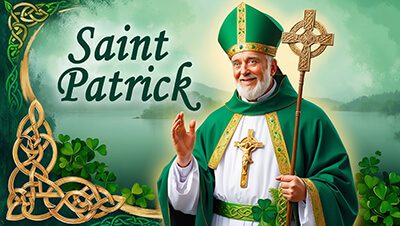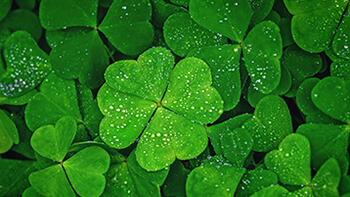
Honoring Saint Patrick
Hymn to God in Nature: May I Sing of Thee?
Saint Patrick, widely celebrated as the patron saint of Ireland, played a transformative role in the religious history of the island. Beyond the shamrocks and legends, Patrick’s legacy lies in his unique approach to spreading Christianity in a land steeped in rich pagan traditions.
Integrating Pagan Traditions
Patrick’s ability to bridge the gap between the earlier pagan beliefs and his new faith helped establish a unique form of Christianity in Ireland. Patrick’s Christianity retained echoes of the ancient pagan symbols and emphasized respect for God in the natural world. This led to a smoother transition to the Christian era and a more enduring religious tradition.
Share this page with a friend!
Watch nearly 400 videos on the Vocal Medicine Channel!
PERSONAL STORY: After leading an evening of singing sacred music a few years back, I was accused of cultural appropriation by one of the attendees. The evening had included music in Hindu, Buddhist and Christian traditions. I was told that I needed initiation from a guru or monk to be qualified to sing in an Eastern tradition. I took the concern seriously. I pondered my own heritage, which is Irish or Celtic.
I started researching the life and philosophy of Saint Patrick, Ireland’s patron saint. I discovered that Saint Patrick wrote beautiful poetry praising God in nature. This echoed the pagan traditions of the Irish people. I was also inspired by the idea that I could ask God directly for permission to sing His praises.
These influences are the origin of my musical response to the cultural appropriation accusation and the birth of the song, “May I Sing of Thee?” In addition, “May I Sing of Thee” is dedicated to James Patrick Wells (1951-2019), beloved husband of my dear friend Donna Wells. James was an ardent lover of life, nature, and God. I hope that this song expresses some part of his spirit of freedom and joy.

Honoring the Life of Saint Patrick
Patrick was born in Britain around 385 AD. He came from a relatively affluent Christian family. At the age of sixteen, Patrick was kidnapped by Irish raiders and sold into slavery. As a result, he spent six years in Ireland tending sheep.
Patrick’s Spiritual Awakening
During this period, Patrick experienced a spiritual awakening. Eventually he escaped from slavery when a dream encouraged him to flee. After returning home to England, Patrick trained for the priesthood and later became a bishop.
Patrick Returns to Ireland
Driven by a vision in which the Irish people called him back to spread the word of God, Patrick returned to Ireland as a missionary. Unlike other missionaries of his time who might have attempted to eradicate native customs entirely, Patrick sought to adapt and integrate aspects of Irish paganism into Christian practice.
Symbols of Saint Patrick
One of Patrick’s most important contributions was his cultural sensitivity. Rather than condemning pagan beliefs and rituals, he reinterpreted them within a Christian framework. Famous examples of this are Patrick’s use of the shamrock and the creation of the Celtic cross.
Symbolism of the Shamrock
While the three-leafed plant had significance in Druidic nature worship, Patrick used it as a visual metaphor to explain the Christian concept of the Holy Trinity—Father, Son, and Holy Spirit—three divine persons in one God.
Meaning of the Celtic Cross
Another symbolic integration was the Christian cross. Patrick is credited with introducing the Celtic Cross, which blends the Christian cross with the pagan symbol of the sun, representing life and energy. This fusion made Christianity appear less foreign and more in tune with the local culture, increasing its appeal among the Irish.
Legends and Wisdom of Saint Patrick
Though many details of Patrick’s life are wrapped in legend—such as the tale of him driving snakes out of Ireland, likely a metaphor for expelling paganism—his historical influence is undisputed. Monasteries became centers of wisdom that continued to respect the natural world and oral storytelling traditions rooted in paganism.
Legacy and Lasting Impact
Patrick engaged with Irish kings and chieftains, gaining their favor and, by extension, the permission to preach to their people. Patrick’s approach laid the groundwork for a unique Irish Christianity. The monastic tradition that followed was deeply intertwined with Irish culture, preserving not only religious doctrine but also local art, literature, and learning.
Cultural Adaptation and Respect
By choosing adaptation over confrontation, Saint Patrick helped Christianity take deep root in Irish soil. His work paved the way for the “Celtic Church,” a vibrant branch of Christianity that flourished independently for centuries and left a profound legacy on Irish identity.
Saint Patrick and Cultural Appropriation
Saint Patrick’s life and mission were defined not only by his personal transformation and devotion but by his rare insight into the power of cultural synthesis. Rather than cultural appropriation, his blending of Christian doctrine with Irish pagan symbols made him not just a missionary, but a bridge between two worlds.
Author Kathleen Karlsen
Kathleen Karlsen is a musician, artist, writer and speaker. She is the author of two books (Flower Symbols and Vocal Medicine) and over 200 articles. Kathleen, her husband Andrew, and their five children live in Bozeman, Montana. More about Kathleen Karlsen.
Honoring Saint Patrick Article Summary
This article tackles the topic of cultural appropriation versus cultural adaptation, citing the example of Saint Patrick’s cultural fusion of paganism and Christianity in his successful missionary work in Ireland. Includes the symbols unique to Saint Patrick including the shamrock and the Celtic cross.
Click for all content on our Site Map
Listen on Spotify!
Click to hear
108x Around the Heart
Click to hear
Vocal Medicine Kirtan





